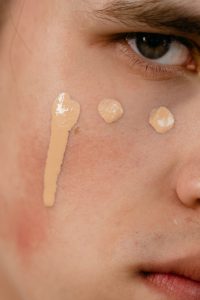Tips for Perfect Foundation Application

If you find it difficult to apply your foundation properly (or if it doesn’t stay in place), don’t worry—you’re not alone. Many people struggle with this common beauty issue. Luckily, there are some easy tips and tricks that can help you get the perfect foundation application every time.
One of the most common mistakes people make when applying foundation is choosing the wrong shade or using the wrong brush. These simple errors can have a big impact on how your makeup looks, so be sure to choose wisely!
Say goodbye to those pesky lines and creases. In this guide, we’ll show you how to apply foundation like a pro—including which brushes work best with which products.
The Fundamentals of Foundation
Foundation is key to evening out skin tone, covering blemishes, and adding color-correcting pigments to splotchy areas of skin. It’s important to get this step right, as it provides the base for the rest of your cosmetics.
However, finding and applying foundation successfully isn’t as straightforward as one might think. The wrong shades, application techniques, and tools can easily result in a disaster.
Color
Knowing your skin tone and undertone is key to finding a foundation that will conceal any imperfections while still looking natural. The right shade should be dark enough to cover up problem areas but light enough so it doesn’t look cakey or obvious.
First Step
If you don’t cleanse, hydrate, and prep your skin before applying foundation, it won’t turn out the way you want it to. Your foundation will get absorbed right away if you put it on dehydrated skin, and powdered makeup will cling to dry patches if you have any.
After you’ve cleansed and hydrated your face, use a primer that locks in moisture. This will not only seal moisture inside your skin but also provide an occlusive layer that lets foundation sit on the surface of your skin instead of being absorbed by it. It additionally helps the foundation “grab” so it stays put after application.
Slow Down
One of the most common complaints regarding foundation is that people use too much product. Although it may be trendy to see Instagram influencers drench their faces in foundation before blending, this technique is neither practical nor attractive.
A little goes a long way with these formulas; remember that you can always add more if needed.
Most foundations are buildable, so another layer on top of the first one is often all it takes to get your desired level of coverage without looking cakey.
Apply Properly
In the early 1990s, many of us were stuck using ineffective sponges to apply our foundation, which only resulted in an unnatural look with visible lines along our jaw and hairline.
Applying makeup doesn’t have to be a complicated process anymore. With foundation brushes, you can easily achieve a natural and blended look in no time.
If you’re unsure of how to properly use the brush, there are plenty of helpful videos online that offer step-by-step instructions.

Choose Your Tools
It’s not only using the right shade and amount of product but also having the best tools to apply your foundation that makes a big difference.
If you’re someone who usually uses makeup sponges but hasn’t been getting the results you want as of late, it might be time to switch gears and use a foundation brush instead.
How to choose the Right Tool?
We always love using our fingers for applying makeup, but brushes and sponges help with blending foundation into small, delicate areas with more precision.
They are also great for creating a flawless base by applying concealer evenly.
Additionally, the type of foundation you use matters because different formulas require different tools to apply correctly.
- A large brush is the best applicator for powder foundations because it provides an even distribution of the product. Unlike fingers or a cotton pad, brushes won’t cause streaking and will prevent absorption of the foundation into the applicator.
- You can use either a brush or sponge for liquid foundation, but each has its own benefits. If you want to thin out the product and add hydration with more precision, go for a sponge. It’ll also come in handy when applying foundation to small areas like under your eyes.
Brushes help you evenly distribute your foundation, creating smooth strokes that help the product adhere to your skin. If you’re using stick foundations, blending with a beauty sponge will erase any lines.
Try These Foundation Tools
Not all foundation brushes and sponges are made the same; some may be constructed with low-quality materials that fall apart easily, or worse, they could harbor bacteria.
To avoid this, it’s best to only purchase from brands you trust for their quality and ethical standards.
- This makeup sponge has a ringed top that provides skin-to-skin application, similar to your fingerprint. This allows for natural and flawless coverage. The latex-free, antimicrobial foam resists harboring bacteria that could cause breakouts.
- At the top of its class, this brush is made of synthetic fibers that have been engineered to feel just like skin. Its abilities to cover pores, press makeup into the skin, and create a flawless finish with every sweep make it unique, and its easy-to-use design helps you get an even application each time.
- If you want to apply any type of powder foundation (loose, pressed, or setting powder) evenly on your skin without looking cakey or creasy, then this face powder brush is a must-have. The dome-shaped bristles are dense and can grab onto the particles of any loose or pressed powder so that it can be distributed evenly across your face.
With the right tools and method in hand, it’s time to consider your foundation’s ingredients. The right application can make your foundation look natural, but choosing healthy ingredients will help keep your skin looking good over time.
Do You Know the Ingredients in Your Foundation?
Look for These
Nature provides excellent ingredients for your skin care routine.
- Endless benefits exist for using jojoba oil on your skin. Its close resemblance in chemical structure to sebum makes it incredibly easy for your skin to absorb, and it is perfect for every skin type. In addition, the antioxidants and nutrients found in jojoba oil make it an excellent way to keep your skin healthy and glowing.
- Coconut oil has many benefits for the skin, including hydration, antioxidant protection, and antifungal properties. Good brands use a cold-centrifuge process to extract the coconut oil before adding it to products so that the nutrients and vitamins are retained.
- The buriti oil plant contains fatty acids, antioxidants, and is a rich source of beta carotene (vitamin A). By using products with this oil, you can help support skin cell regeneration, collagen and elastin production. As a result, your skin will look smoother, better hydrated, and more youthful overall.
Avoid These
Many popular foundations contain unhealthy ingredients that can damage your skin or the environment.
- Many common synthetic fragrances contain harmful toxins and skin irritants, yet companies are not required to disclose this information on the product packaging. As a result, consumers are generally unaware of the dangers these artificial scents pose.
- Sulfates are often added to foundation as a way to help the product be absorbed better into the skin. The downside to sulfates is that they are known skin irritants and are almost always accompanied by other toxic ingredients in products.
- Retinol. Many foundations incorporate retinol because it’s trendy, but what people don’t realize is how dangerous it is. Retinol makes your skin more susceptible to the sun’s harmful rays, which is why you should only use products with this ingredient in them at night.
The Perfect Foundation Starts With the Right Brush
If you’re having trouble getting your foundation to look perfect, it’s time to invest in a new brush. The right tools will help you create a flawless finish.



